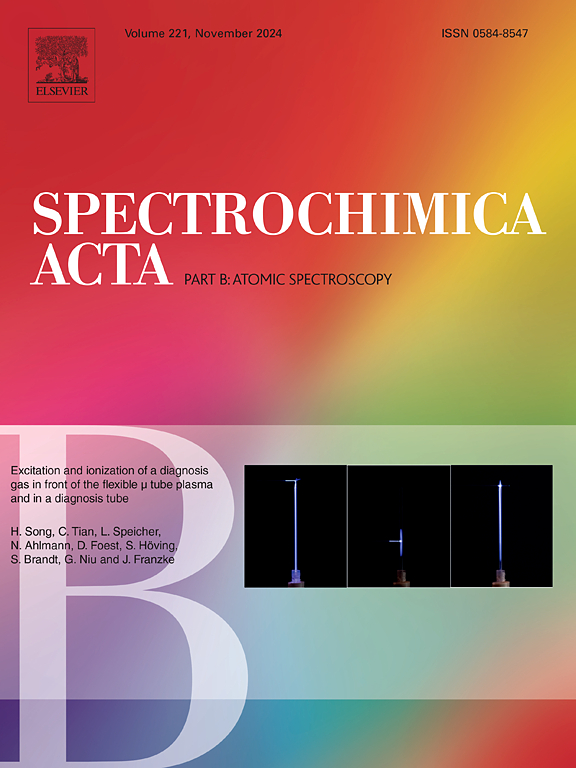Optimization of denoising approaches in the context of ultra-fast LIBS imaging
IF 3.2
2区 化学
Q1 SPECTROSCOPY
引用次数: 0
Abstract
Laser-Induced Breakdown Spectroscopy (LIBS) has emerged as a powerful analytical tool capable of providing multi-elemental information from a single laser pulse with minimal sample preparation. This technique generates a laser-induced, transient plasma on the sample surface, whose spectral emission is analyzed to determine its elemental composition. μLIBS-Imaging, a variant offering spatially resolved elemental analysis, holds promise for applications in diverse fields such as industry, geology, forensics, and biomedicine. Our drive to go ever faster and analyze increasingly larger areas of interest in samples now compels us to use kHz lasers for this elemental imaging. Despite its potential, implementing such lasers in μLIBS-imaging would face diverse challenges mainly related to weak plasma emission and signal-to-noise ratio (SNR) degradation, particularly when applied to delicate biological samples. This paper investigates methods to enhance SNR in fast μLIBS imaging, particularly for biomedical applications. We focus on denoising techniques suitable for high-frequency laser applications, comparing methods like Savitzky-Golay smoothing, Fast Fourier Transform, wavelet-based filtering, Whittaker Filtering, and Principal Component Analysis (PCA). Our strategy optimizes denoising parameters for specific elemental emission peaks, enhancing SNR for individual elements of interest. The results demonstrate significant improvements in data quality, paving the way for more accurate and efficient elemental imaging in complex biomedical specimens.

超快速LIBS成像降噪方法的优化
激光诱导击穿光谱(LIBS)已经成为一种强大的分析工具,能够从单个激光脉冲中提供多元素信息,并以最少的样品制备。该技术在样品表面产生激光诱导的瞬态等离子体,分析其光谱发射以确定其元素组成。μLIBS-Imaging是一种提供空间解析元素分析的变体,有望在工业、地质、法医和生物医学等不同领域应用。我们的动力越来越快,分析越来越大的兴趣区域的样品,现在迫使我们使用千赫激光进行元素成像。尽管具有潜力,但在μ libs成像中实现这种激光器将面临各种挑战,主要与弱等离子体发射和信噪比(SNR)退化有关,特别是当应用于精细的生物样品时。本文研究了在快速μLIBS成像中提高信噪比的方法,特别是在生物医学应用中。我们专注于适合高频激光应用的去噪技术,比较了Savitzky-Golay平滑、快速傅立叶变换、基于小波的滤波、惠特克滤波和主成分分析(PCA)等方法。我们的策略优化了特定元素发射峰的去噪参数,提高了单个感兴趣元素的信噪比。结果表明,数据质量显著提高,为复杂生物医学标本中更准确、更有效的元素成像铺平了道路。
本文章由计算机程序翻译,如有差异,请以英文原文为准。
求助全文
约1分钟内获得全文
求助全文
来源期刊
CiteScore
6.10
自引率
12.10%
发文量
173
审稿时长
81 days
期刊介绍:
Spectrochimica Acta Part B: Atomic Spectroscopy, is intended for the rapid publication of both original work and reviews in the following fields:
Atomic Emission (AES), Atomic Absorption (AAS) and Atomic Fluorescence (AFS) spectroscopy;
Mass Spectrometry (MS) for inorganic analysis covering Spark Source (SS-MS), Inductively Coupled Plasma (ICP-MS), Glow Discharge (GD-MS), and Secondary Ion Mass Spectrometry (SIMS).
Laser induced atomic spectroscopy for inorganic analysis, including non-linear optical laser spectroscopy, covering Laser Enhanced Ionization (LEI), Laser Induced Fluorescence (LIF), Resonance Ionization Spectroscopy (RIS) and Resonance Ionization Mass Spectrometry (RIMS); Laser Induced Breakdown Spectroscopy (LIBS); Cavity Ringdown Spectroscopy (CRDS), Laser Ablation Inductively Coupled Plasma Atomic Emission Spectroscopy (LA-ICP-AES) and Laser Ablation Inductively Coupled Plasma Mass Spectrometry (LA-ICP-MS).
X-ray spectrometry, X-ray Optics and Microanalysis, including X-ray fluorescence spectrometry (XRF) and related techniques, in particular Total-reflection X-ray Fluorescence Spectrometry (TXRF), and Synchrotron Radiation-excited Total reflection XRF (SR-TXRF).
Manuscripts dealing with (i) fundamentals, (ii) methodology development, (iii)instrumentation, and (iv) applications, can be submitted for publication.

 求助内容:
求助内容: 应助结果提醒方式:
应助结果提醒方式:


